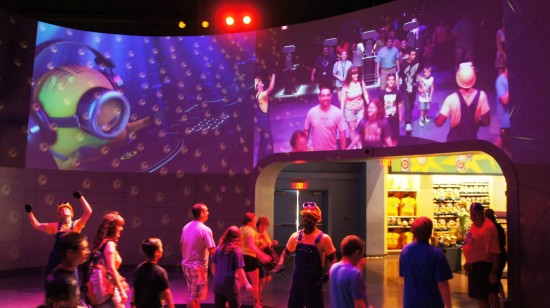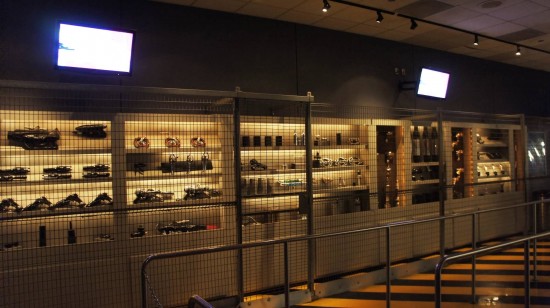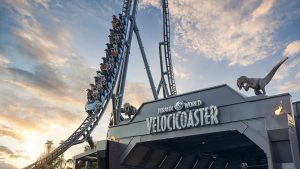The modern-day theme park attraction is a multi-faceted entity. There’s the queue, which, at the present moment, is undergoing a transformation from decorated-but-passive waiting room to fully-integrated-immersive experience. And the ride itself has, over the course of the past 20 years, taken on more complexities, often in the form of action-movie-esque thrills, in an effort to more fully engage riders.
But there has been no (large-scale) movement to upgrade and integrate the final critical section of the themed experience: the transition back out into the everyday world of the park, with its blistering sun and throngs of people and parked cars. What nearly 60 years of theme parks have given us is leaving the fun and magic of the ride to immediately be dumped into a gift shop; indeed, exiting through retail has become such a ubiquitous phenomenon that books and even companies have been named after it. There has to be more to offer here.
But what, exactly? It’s admittedly easy – or, at the very least, obvious – to discern what the role of the first two areas of attractions should be and, from there, how to improve upon them to maximize guest enjoyment. The transition back is, by its very nature, more nebulous – what is the fundamental goal, let alone its mechanics of integration?
An early – and still-developing – school of thought on this is to theme-to-distract, which Disney in particular has been spearheading at Magic Kingdom: “play” musical instruments while waiting to venture into the Haunted Mansion or unleash your children in a giant playground to kill time waiting for your restaurant-style buzzer to go off for Dumbo. And, indeed, Universal has picked up this idea and run with it for Despicable Me: Minion Mayhem, which allows guests to engage in a color-saturated dance party with costumed MCs and computer-generated overlays on the screens around you after exiting the ride. (Don’t worry – the gift shop is still there, patiently awaiting riders to finish busting their moves.)

These approaches, of course, aren’t entirely superfluous in terms of their theming; Dumbo, for instance, did prominently feature a big-top circus, and the Despicable Me characters did dance their way over to the credit sequence. But there still remains the question of how these activities advance the story, that mysterious and driving force of any themed enterprise. How do visitors walk out of these areas better understanding the characters or the world or theme of the universe they had just spent up to an hour or two of their lives inhabiting?
While waiting in line for Disaster Transport, a somewhat unique – and thoroughly underwhelming – enclosed bobsled rollercoaster at Cedar Point here in Ohio, a friend of mine noted the completely unenthusiastic employee stuck with manning a barebones gift stand that sold ‘80s-style glow-in-the-dark paraphernalia. While we lamented her job – Disaster Transport should have been closed some 10 or 15 years ago, and not just this past summer – the sight did instigate a rather interesting conversation. Why don’t more designers implement gift shops before the ride instead of at the end? There’s no better definition of a captive audience, one that moves sluggishly along predetermined lanes as opposed to being unleashed in timed torrents to zigzag randomly through the store. Yes, baggage considerations must play a role here (particularly if we’re talking about such stringent rides as Harry Potter and the Forbidden Journey), but if Disney and Universal can implement a system that delivers packages to the park’s front gates or, even, to your hotel room clear across the resort, why can’t they route a customer’s package to the other end of the ride building, on your way out the door? And while waiting to pick up your package, why not then have the chance to soak up some last-minute theming – music, audio-animatronic figures, actors, even movie clips? It would be the difference between a kiss goodnight and being booted out of the bed.

In story terms, this after-the-ride narrative space would be called the epilogue or tag, a brief chapter that puts a cap on the plot or a final chance to say goodbye to the characters. Brendan Fraser’s bit with the cup of coffee at the end of Revenge of the Mummy would feel much better placed in the transition rather than being forced into a somewhat awkward position in the ride proper. Having a gaggle of reporters and groupies swooning over you, taking your picture (which, of course, could be purchased at the gift shop a bit further on) after finishing the music video that is Hollywood Rip Ripe Rockit would be sublime. And just think what Harry and friends could do at the Wizarding World…
Call this exiting through narrative.
[sws_author_bio user=”msunyata@yahoo.com” size=”105″ authorposts=”More OI posts by Marc” name_format=”About the author”] [/sws_author_bio]


It’s an interesting thought. I feel that while it may be a great theming technique (like the new games at the Simpsons Ride), it may also irritate people. Lines, regardless of theme, are viewed as a nuisance. Adding on retail to that might only add to the irritation, particularly for families with small impulsive children.